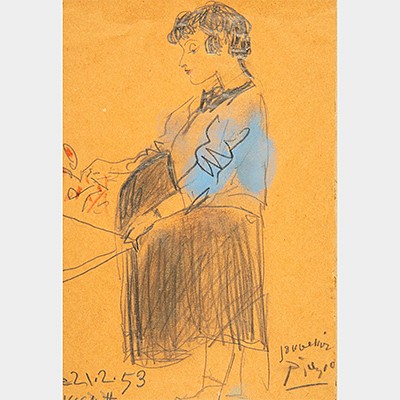JOAN PONÇ BONET (Barcelona, 1927 - Saint-Paul, France, 1984). "Geometric Metaphysics", ca. 1969. Oil on canvas. Signed on the back.
Lot 66
About Seller
Setdart Auction House
Carrer Aragó 346
Barcelona
Spain
Setdart Subastas was born in 2004 and is currently the first online art auction in Spain with solidity, prestige and reliability guaranteed by our more than 60,000 users. Setdart has a young, dynamic and enterprising team ready to successfully manage the purchase and sale of art works through custom...Read more
Estimate:
EUR€18,000 - EUR€20,000
$19,354.84 - $21,505.38
Absentee vs Live bid
Two ways to bid:
- Leave a max absentee bid and the platform will bid on your behalf up to your maximum bid during the live auction.
- Bid live during the auction and your bids will be submitted real-time to the auctioneer.
Bid Increments
| Price | Bid Increment |
|---|---|
| EUR€0 | EUR€10 |
| EUR€200 | EUR€25 |
| EUR€500 | EUR€50 |
| EUR€1,000 | EUR€100 |
| EUR€3,000 | EUR€200 |
| EUR€5,000 | EUR€500 |
| EUR€10,000 | EUR€1,000 |
| EUR€20,000 | EUR€2,000 |
| EUR€50,000 | EUR€5,000 |
About Auction
By Setdart Auction House
Sep 20, 2021
Set Reminder
2021-09-20 08:00:00
2021-09-20 08:00:00
America/New_York
Bidsquare
Bidsquare : CONTEMPORARY ART
https://www.bidsquare.com/auctions/setdart-auction-house/contemporary-art-7482
Setdart Auction House sofia@setdart.com
Setdart Auction House sofia@setdart.com
- Lot Description
JOAN PONÇ BONET (Barcelona, 1927 - Saint-Paul, France, 1984). "Geometric Metaphysics", ca. 1969. Oil on canvas. Signed on the back. Work exhibited in "Joan Ponç: Retrospective exhibition". Zaragoza, 18 February to 12 March 1994. Work referenced in the artist's online catalogue raisonné with catalogue number 0635. Measurements: 150 x 150.4 cm; 154 x 154 cm (frame). Faithful to the precepts of the artistic group Dau al Set, Joan Ponç delved into a visceral automatism that allowed him to connect surrealism and the inner world. His metaphysical and ambiguous dream landscapes find references in the most human miseries, as shown in his series "Metafísica geométrica", with works characterised by abstraction and large format, dated between 1969 and 1970. He was a true visionary who plunged into inner universes to show us the darkest and most hidden corners of the depths of the human being. For Ponç, art is nothing more than an introduction to the mystery and secrets of the spirit. A painter and draughtsman, he trained in Barcelona, in the studio of Ramón Rogent and at the Academy of Plastic Arts with Ángel López-Obrero. After devoting himself to painting and drawing in anonymity, he held his first individual exhibition in 1946 at the Galería Arte in Bilbao, which was to be his definitive establishment on the national art scene. In 1948, together with Tharrats, Puig, Cuixart, Tàpies and Brossa, among others, he founded the avant-garde group Dau al Set. Selected by Eugenio D'Ors, he took part in the Salón de los Once in Madrid in 1951 and 1952. In 1952 he took part in the Hispano-American Biennial, and the following year he spent some time in Paris, where he met Joan Miró and managed to exhibit at the Musée de la Villa. On the latter's recommendation, Ponç gained access to Brazilian artistic circles, settling in São Paulo from 1953 to 1962. In 1954, the year Dau al Set disbanded, he held an exhibition at the city's Museum of Modern Art, which was so successful that the organisation acquired all his works. In Brazil he visited the equatorial jungles, where he was impressed by their fauna, especially insects, which he incorporated into his imagery. In 1955 he founded the Taüll group with Marc Aleu, Modest Cuixart, Jaume Guinovart, Jaume Muxart, Mercadé, Tàpies and Tharrats. After returning to Catalonia due to illness, as a fully established artist he shows his work in New York, Rio de Janeiro, Bonn, Paris, Frankfurt, Geneva, Antibes and various Spanish cities. In 1965 he won the International Grand Prize for Drawing at the São Paulo Biennial. Ponç's production can be divided into six periods: the Dau al Set period (1947), the Brazilian period (1958), the metaphysical-geometric period (1969), the period of the metaphysical characters (1970), the acupainting period (1971) and a final period of synthesis (1972). One of the most singular and enigmatic painters in the history of modern art, Ponç painted in order to survive the world, and turned each of his creations into a magical act. His trajectory describes a circular path over the years, almost without evolution, if we understand as such the change from one language to another, the variation of styles, the transformation of the unknowns that led him to paint. Ponç was a painter-poet, who used his brushes to discover the only world he knew, the most real of all, the world that lies at the bottom of his own being. He is currently represented at the Museum of Contemporary Art of the University of São Paulo, the Museo Patio Herreriano in Valladolid, the MACBA in Barcelona, the Basque Centre-Museum of Contemporary Art in Vitoria, and the Museo Nacional Centro de Arte Reina Sofía.
- Shipping Info
-
In-house shipping available. Please inquire at admin@setdart.com.
-
- Buyer's Premium



 EUR
EUR CAD
CAD AUD
AUD GBP
GBP MXN
MXN HKD
HKD CNY
CNY MYR
MYR SEK
SEK SGD
SGD CHF
CHF THB
THB













